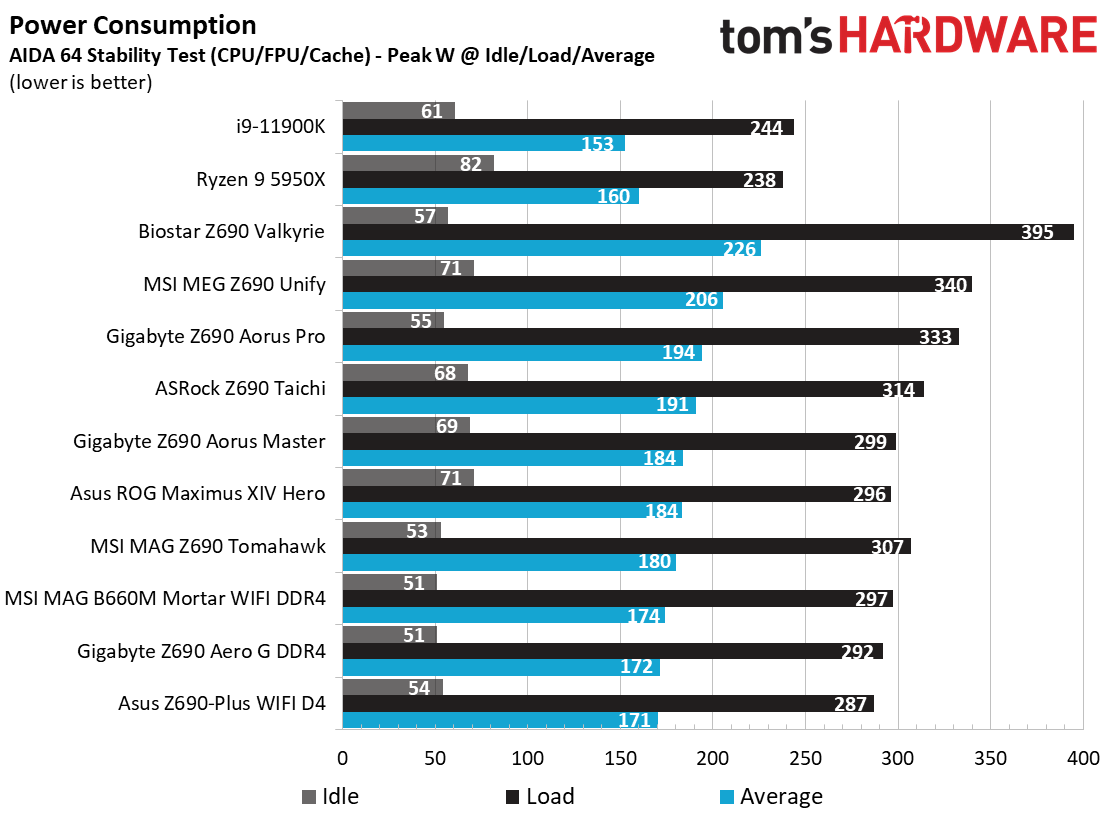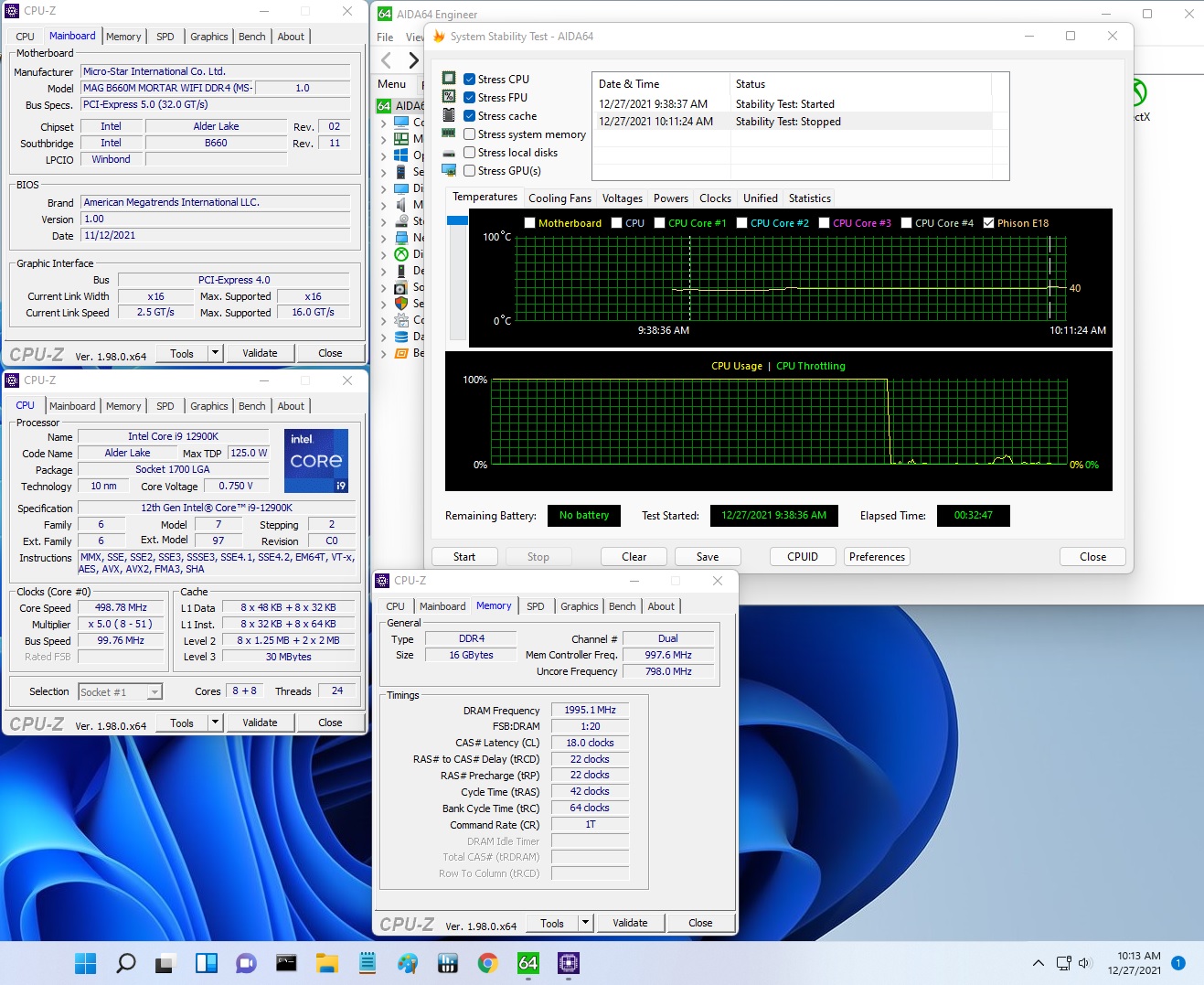Why you can trust Tom's Hardware
Our standard benchmarks and power tests are performed using the CPU’s stock frequencies (including any default boost/turbo), with all power-saving features enabled. We set optimized defaults in the BIOS and the memory by enabling the XMP profile. The Windows power scheme is set to Balanced (default) for this baseline testing, so the PC idles appropriately. To get the most out of the Intel Alder Lake chips, you need to be on Windows 11 with its updated scheduler. In most cases, Windows 10 performs well. However, some tests (Cinebench R20, Corona and POVRay) take a significant hit. In short, if you’re going with Alder Lake, you must upgrade to Windows 11 for the best results across the board. That may change with patching and updates. We’ll keep you posted.
Synthetic Benchmarks
Synthetics are a great tool to determine how a board runs, as identical settings should produce similar performance results. Turbo boost wattage and advanced memory timings are places where motherboard makers can still optimize for either stability or performance, though, and those settings can impact some testing.
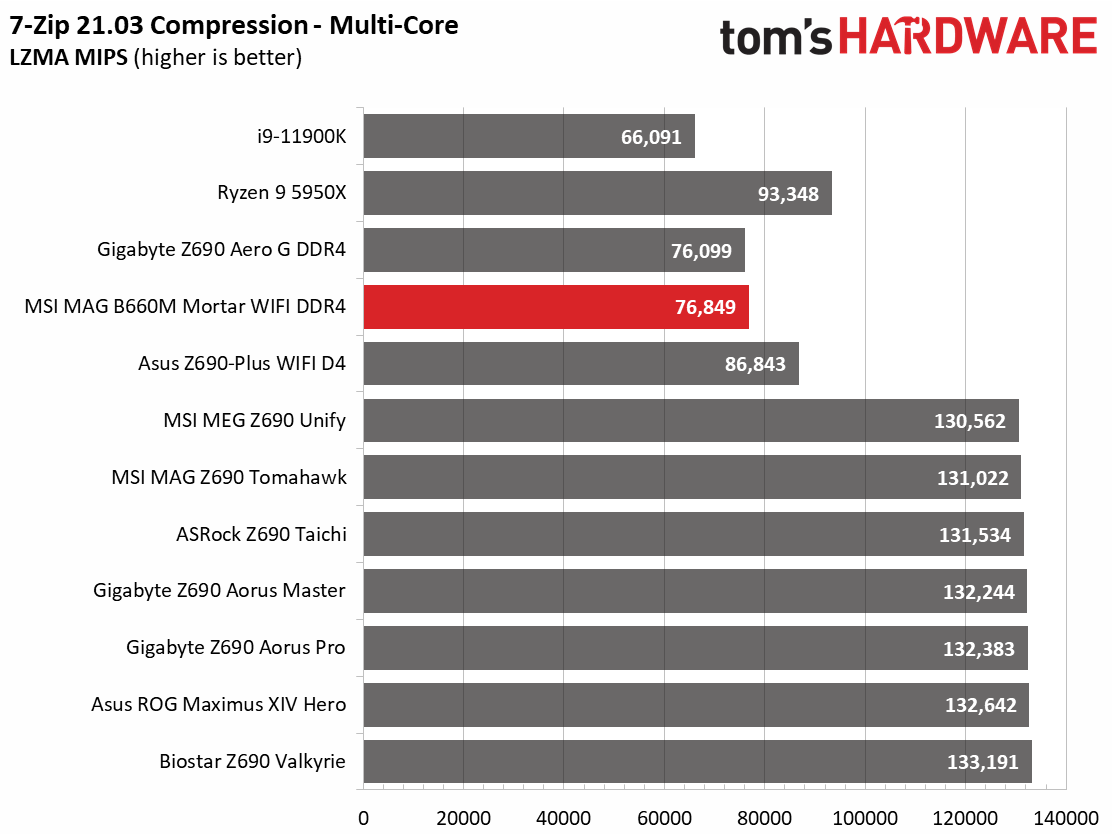
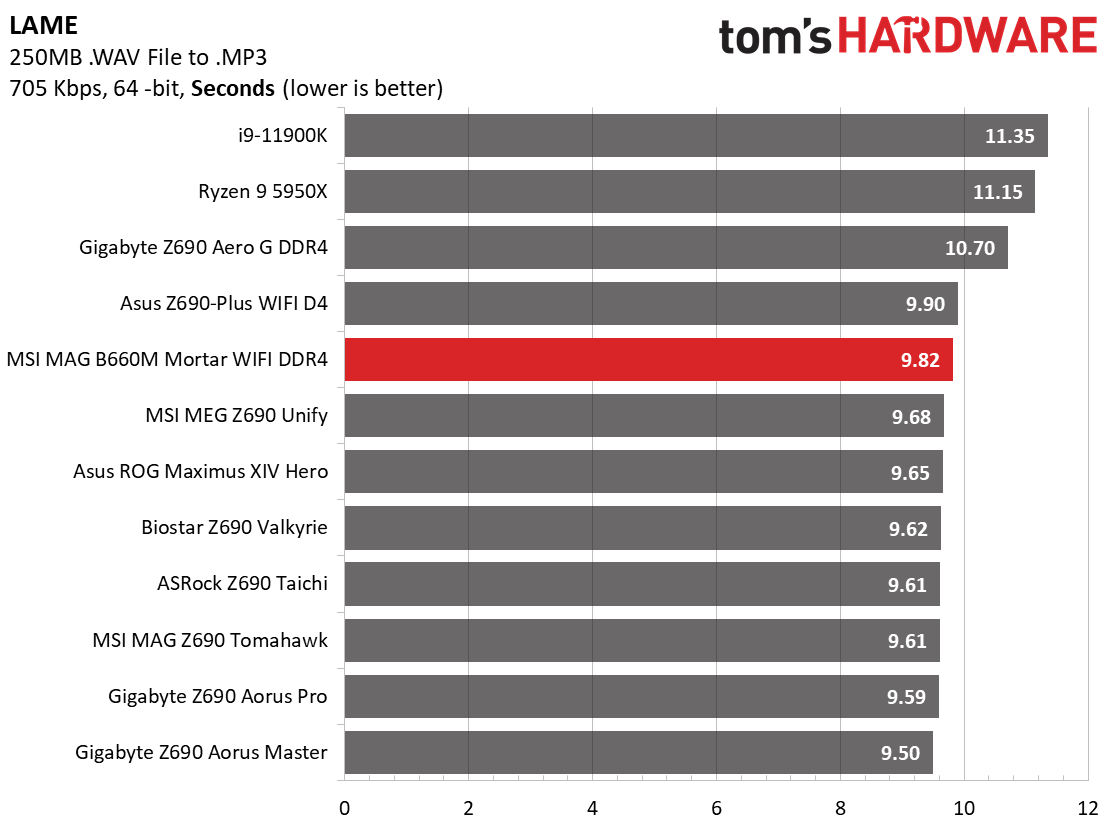
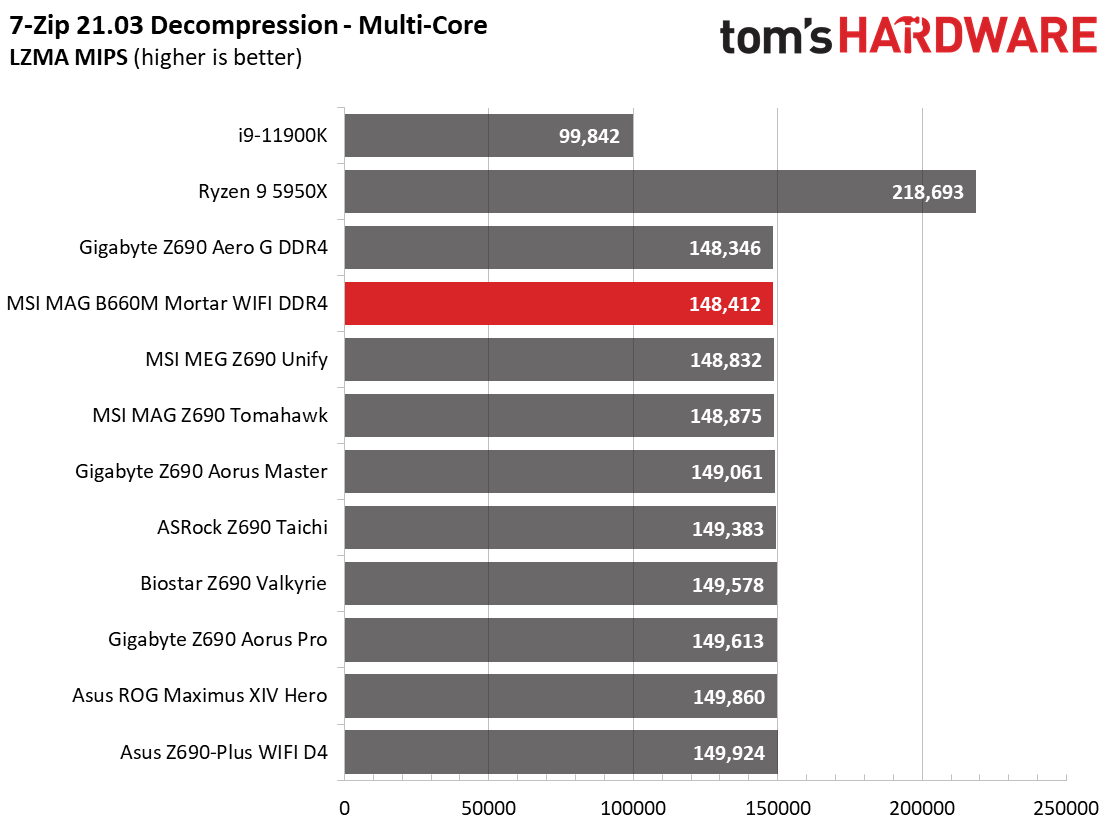
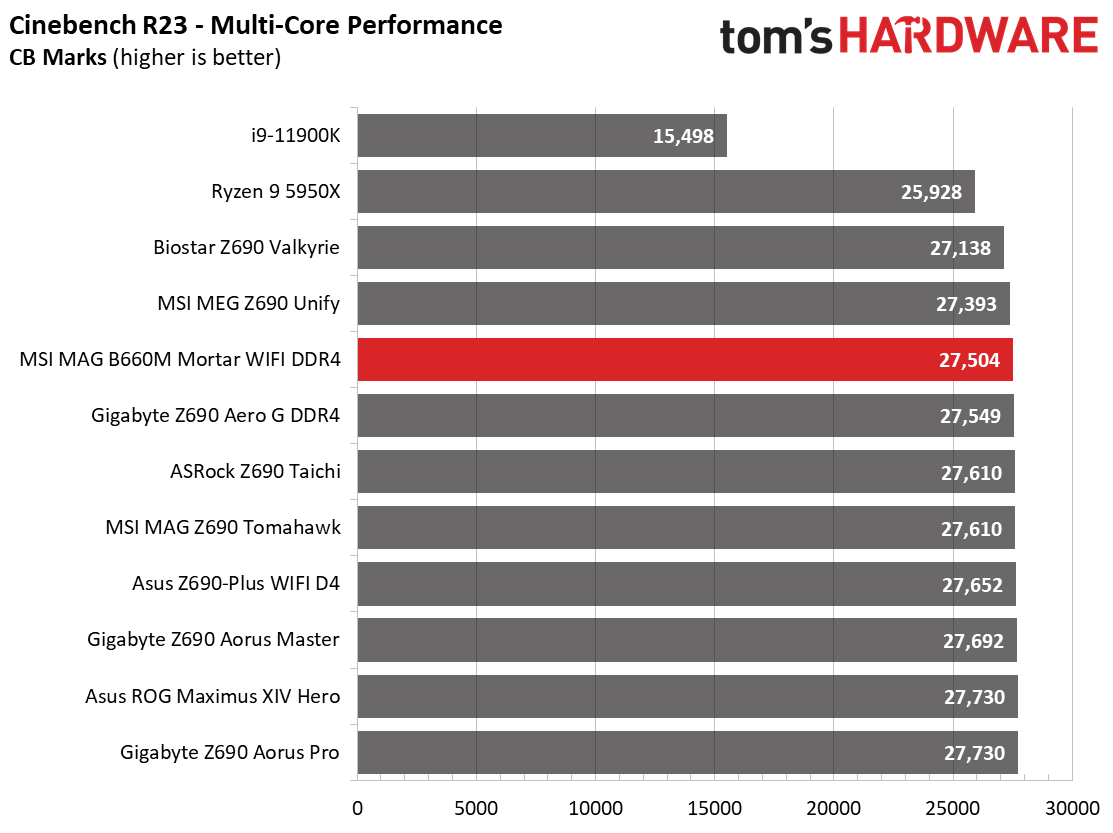
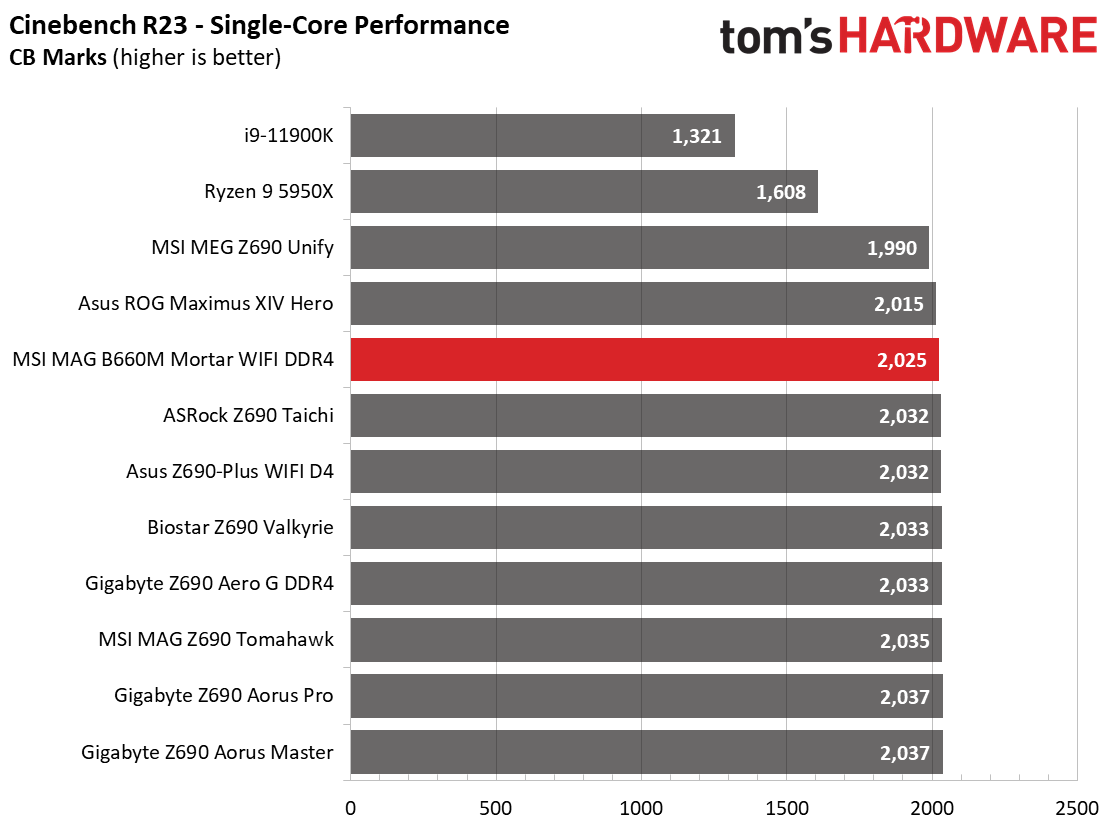
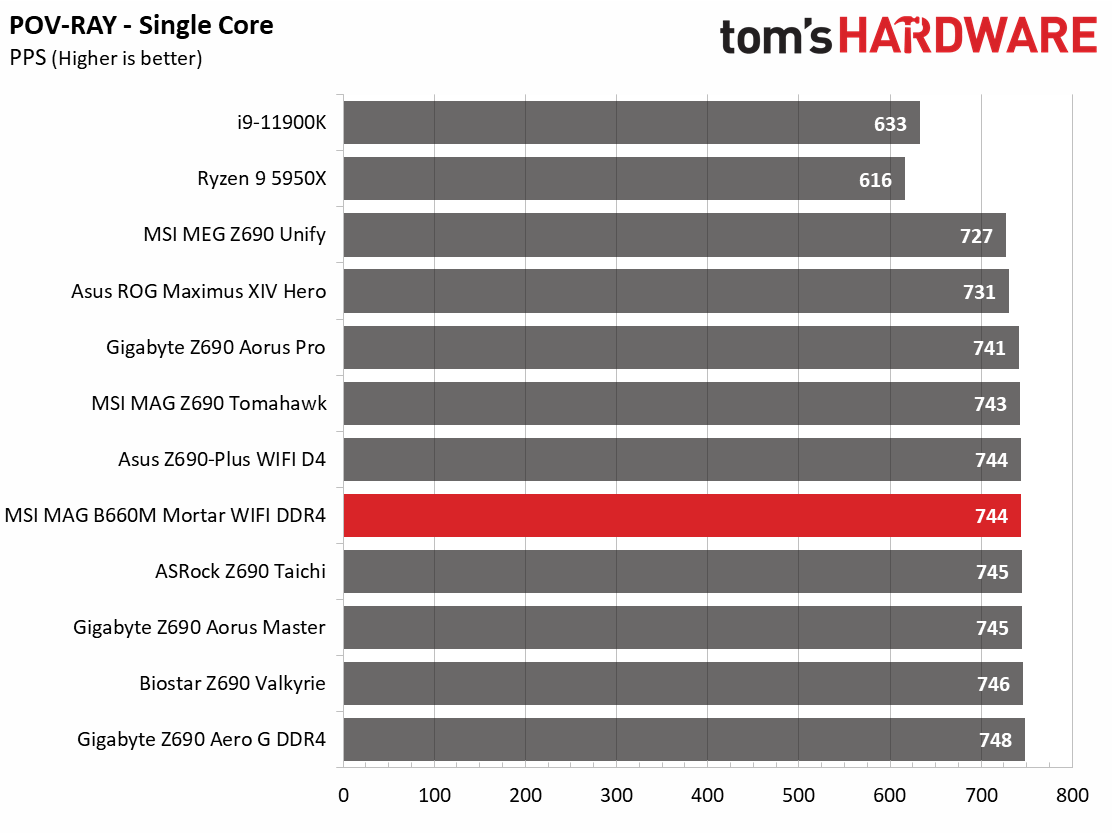
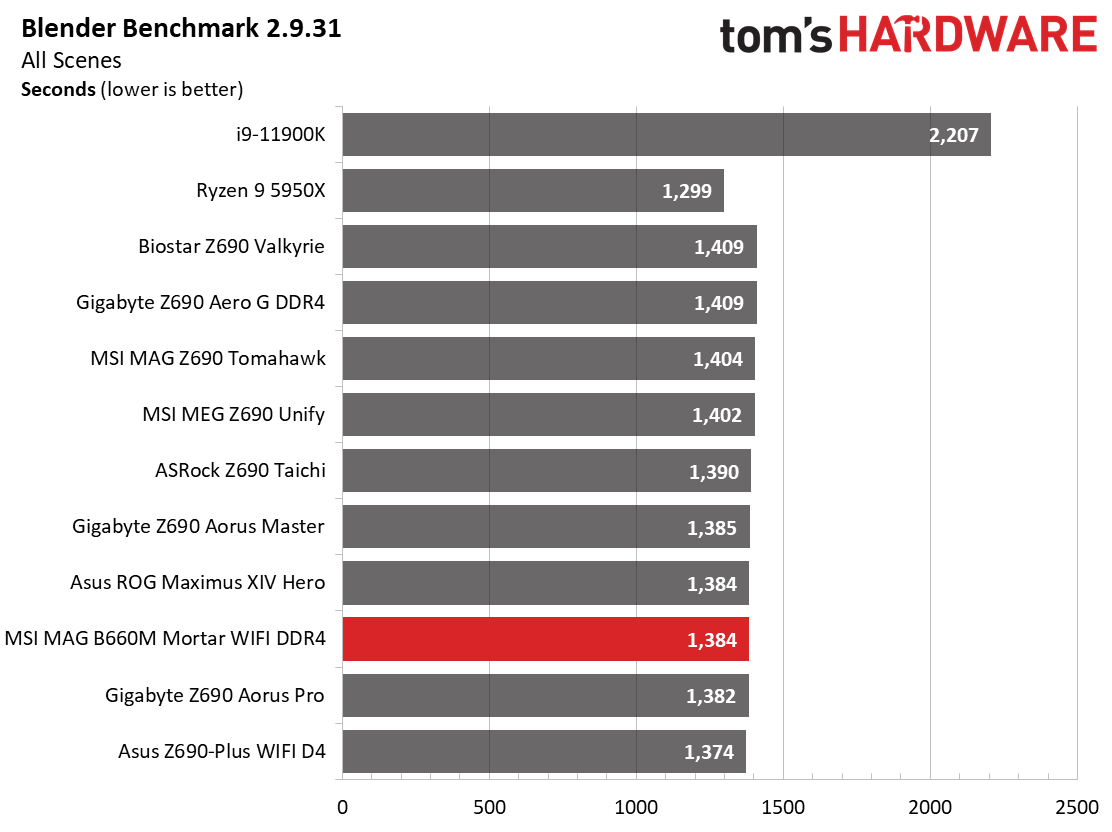
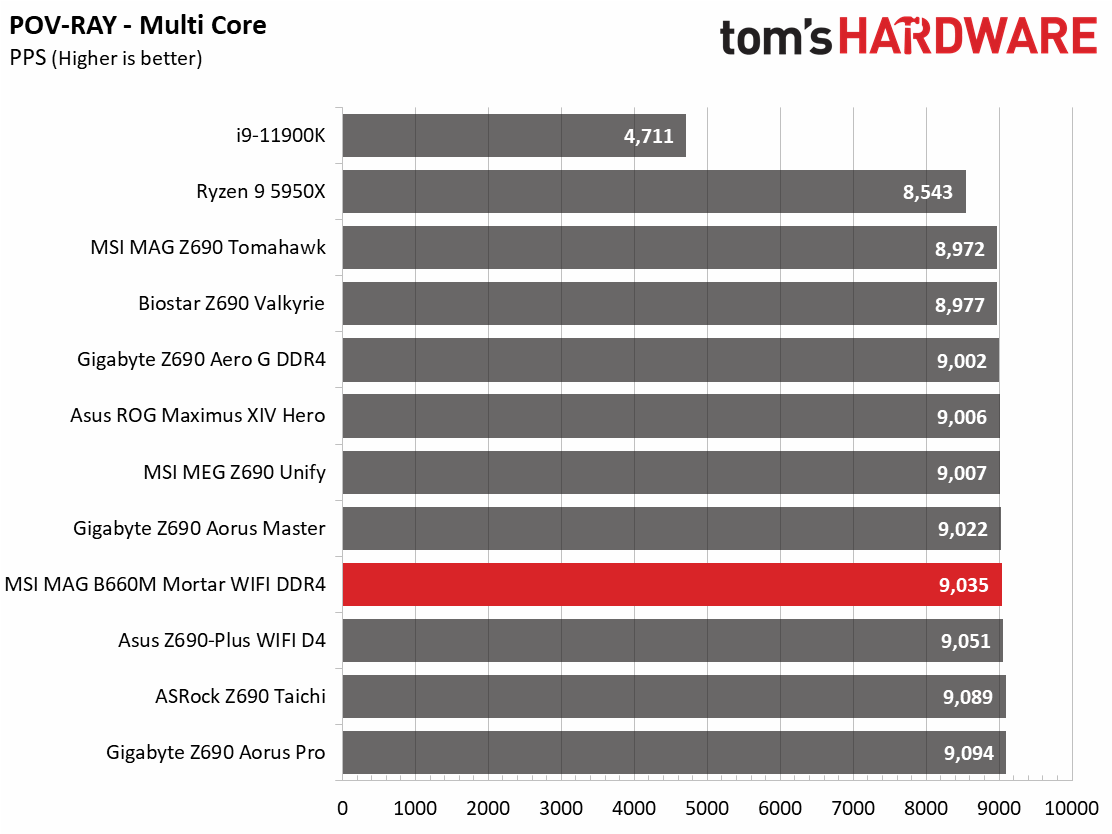
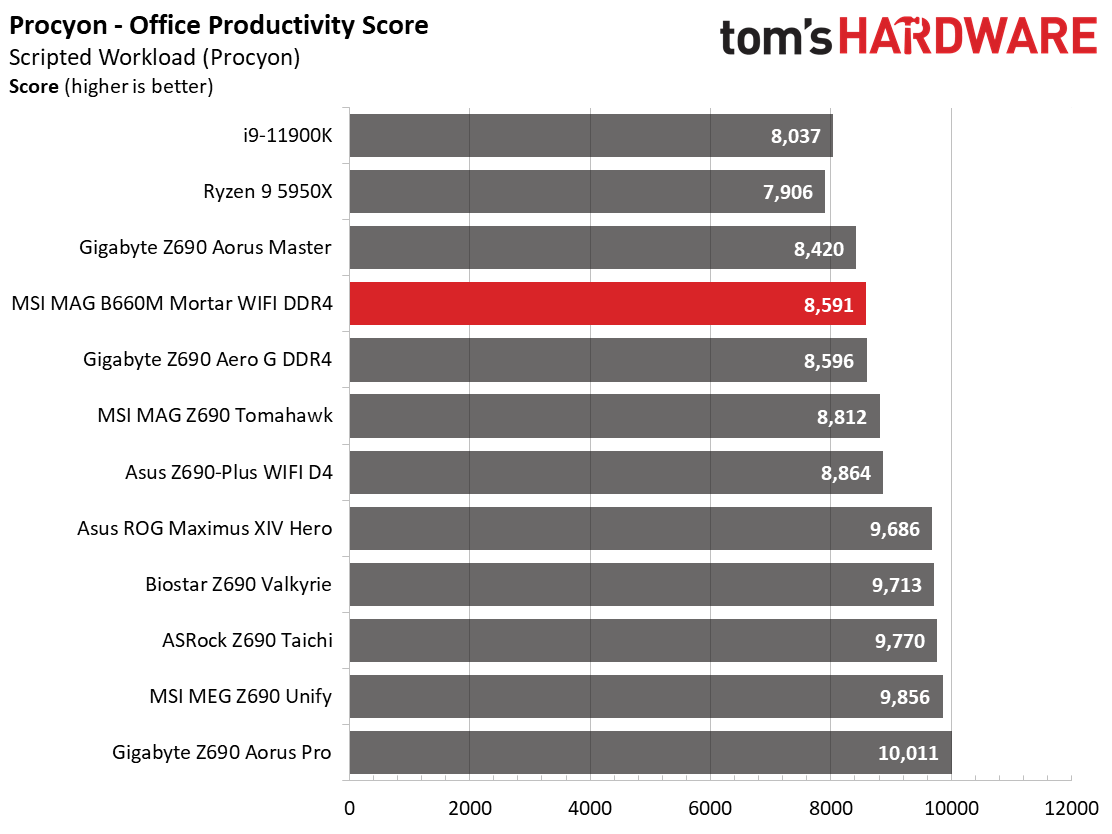

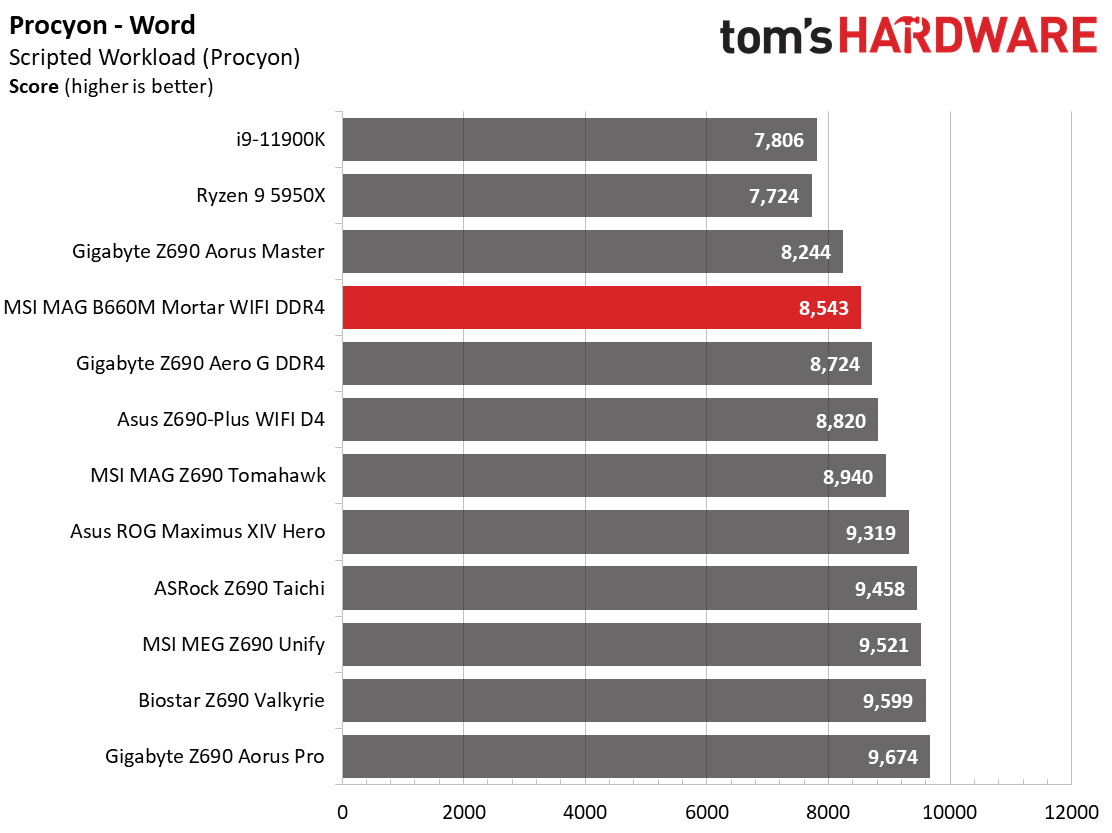
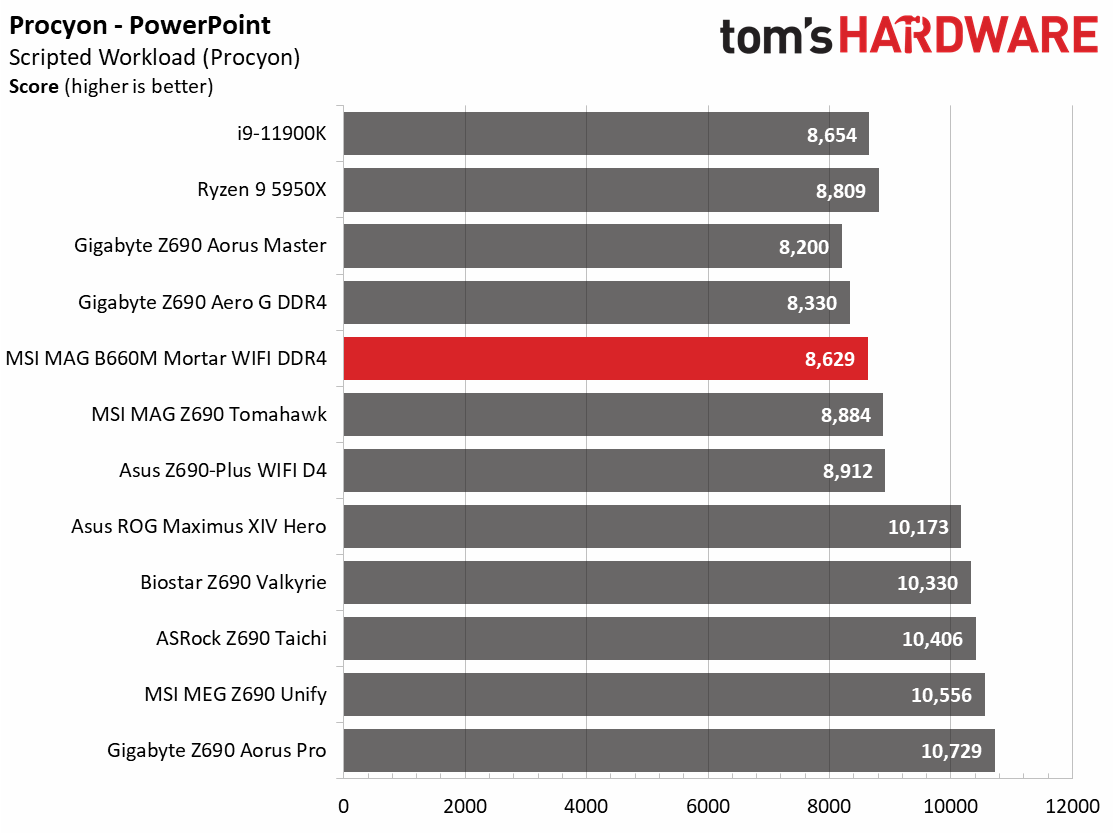
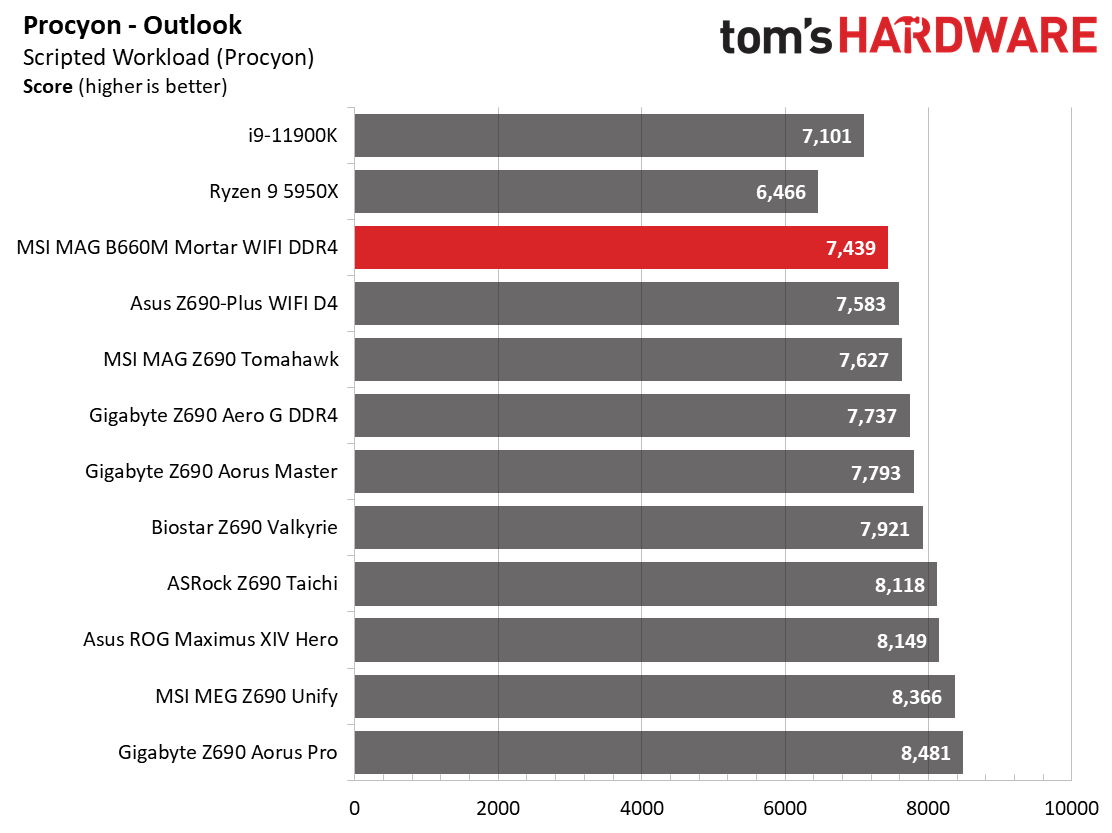
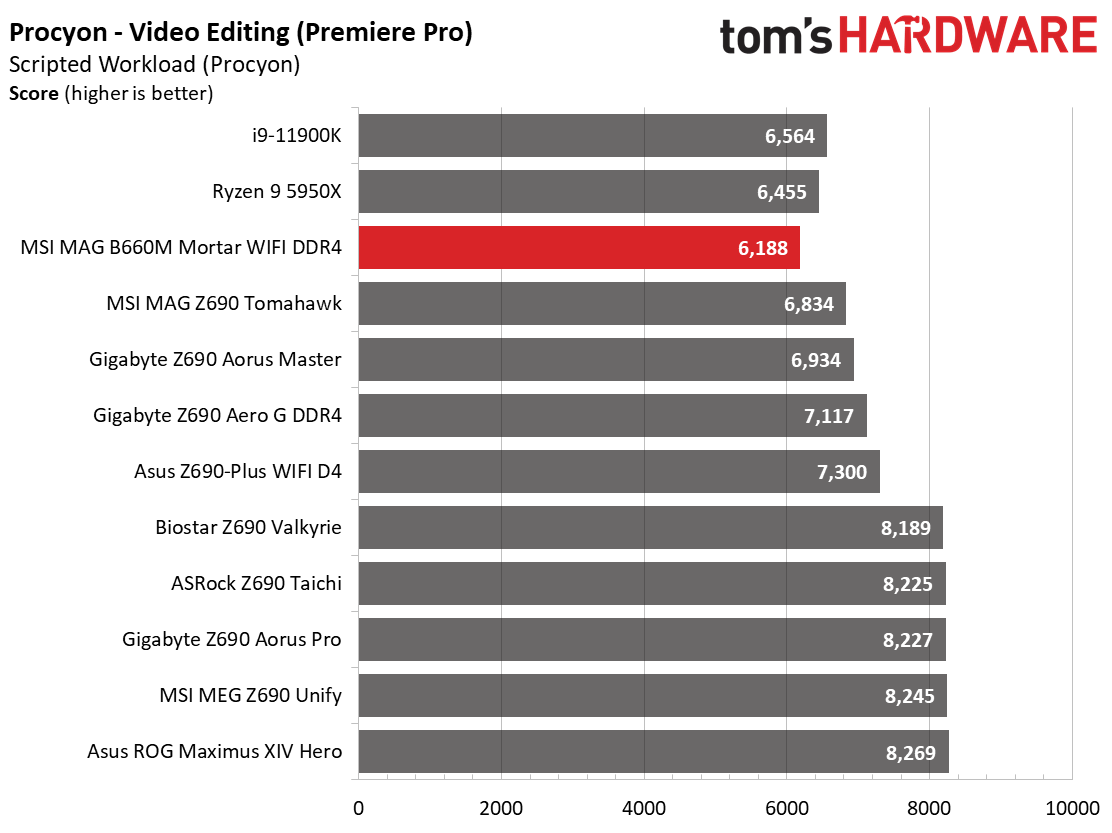
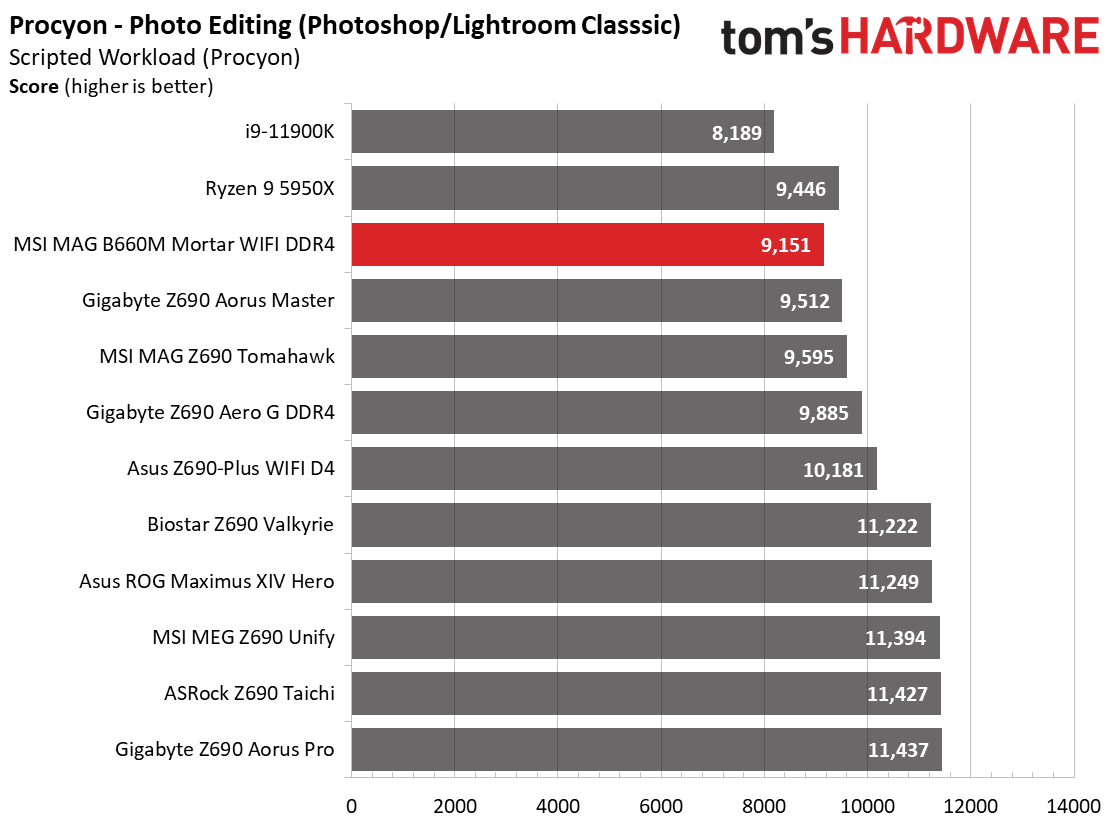
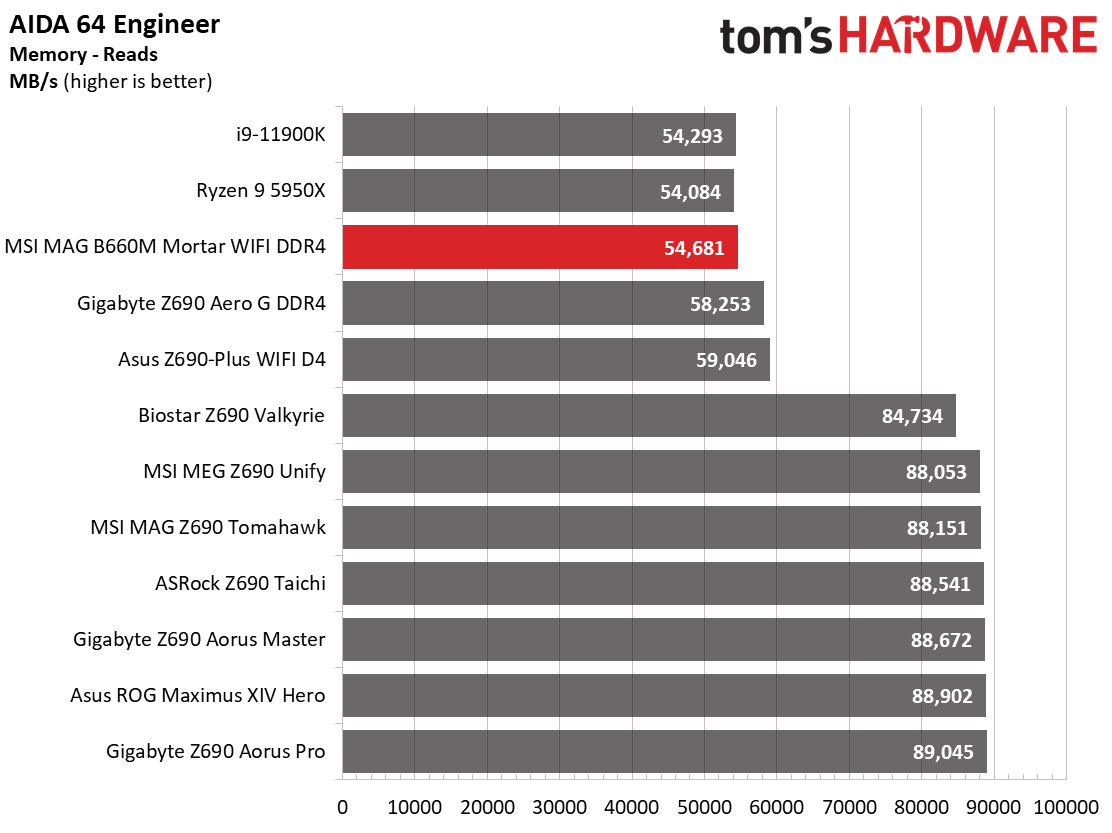
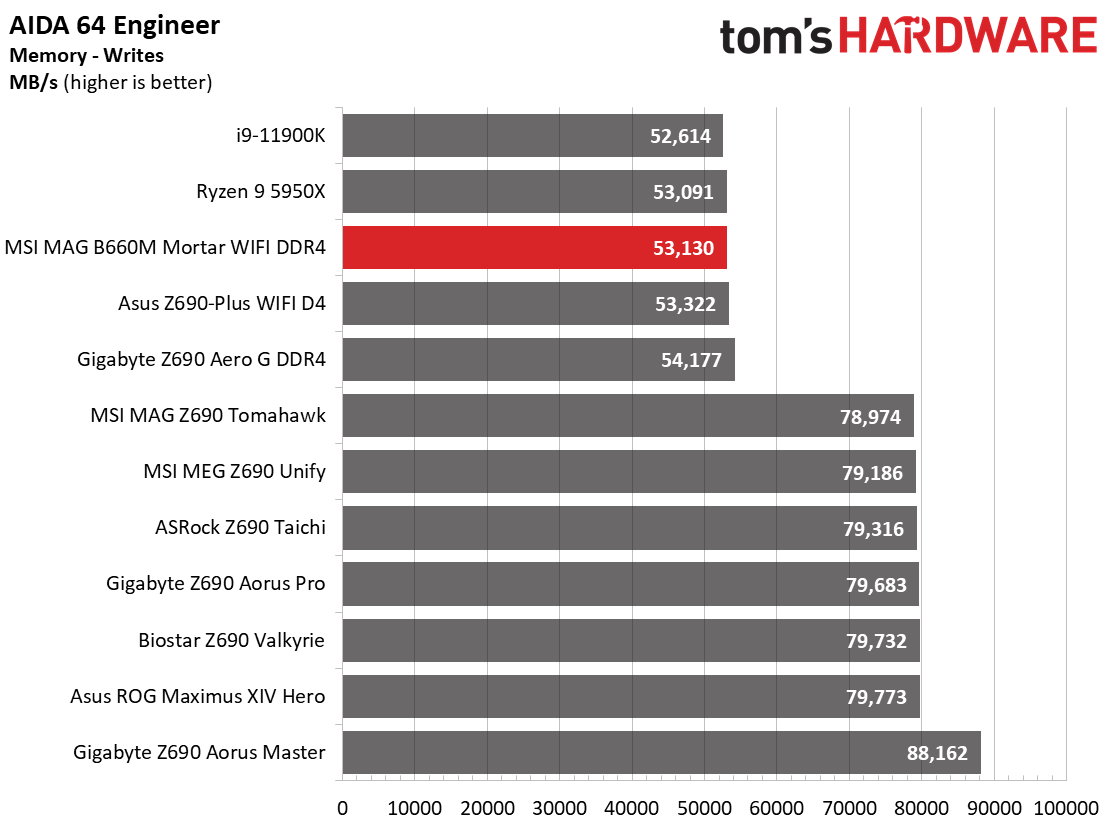
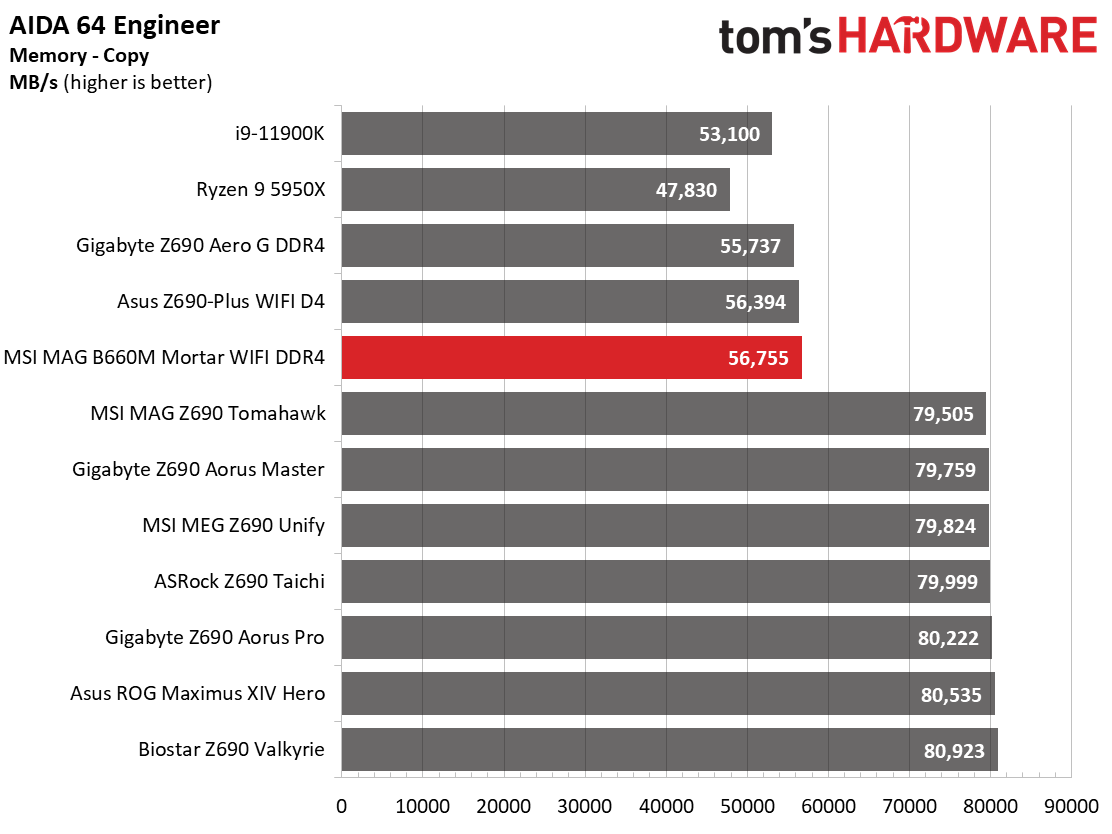
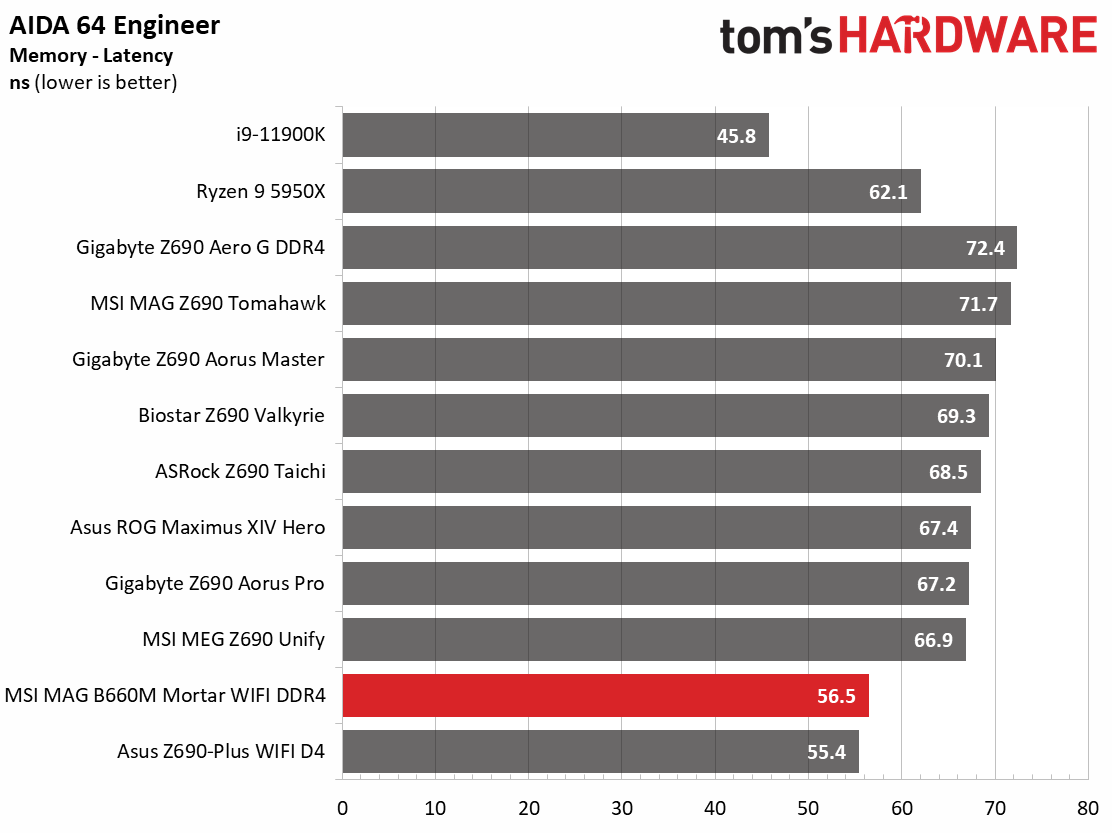
The budget-friendly B660M Mortar WIFI DDR4’s results blended in well with the others and performed as well as the DDR5 boards in most tests. Previously, we found that the 7Zip compression results are notably slower with DDR4, and that trend continues with the Mortar. Cinebench R23 and POV_Ray results matched other DDR5 boards too, but the Procyon Suite that includes MS Office, Video and Photo Editing benchmarks were slower overall by a couple percent.
AIDA test results were as expected, matching bandwidth from the previous DDR4 systems. Using our DDR4 3600 sticks, the Mortar ran these in Gear 1 by default, which yielded a middle of the (DDR4) pack latency result. In short, we didn’t find anything of concern during our memory testing.
Timed Applications
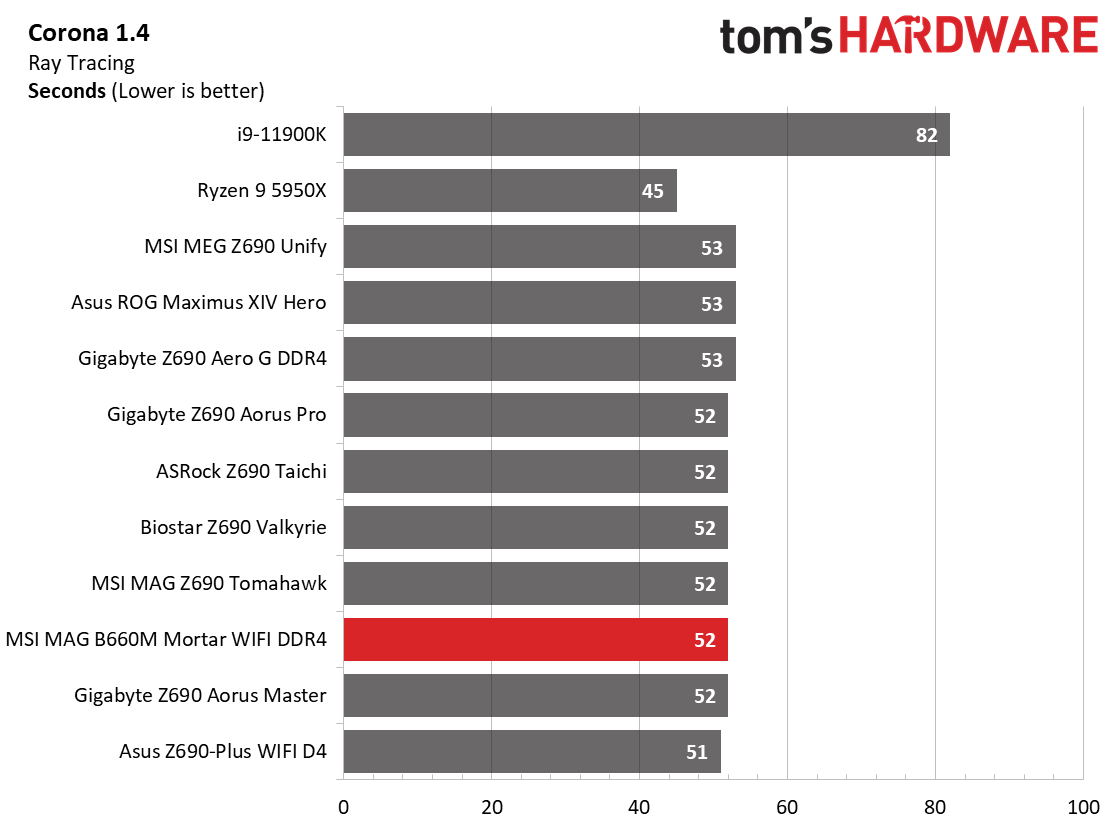
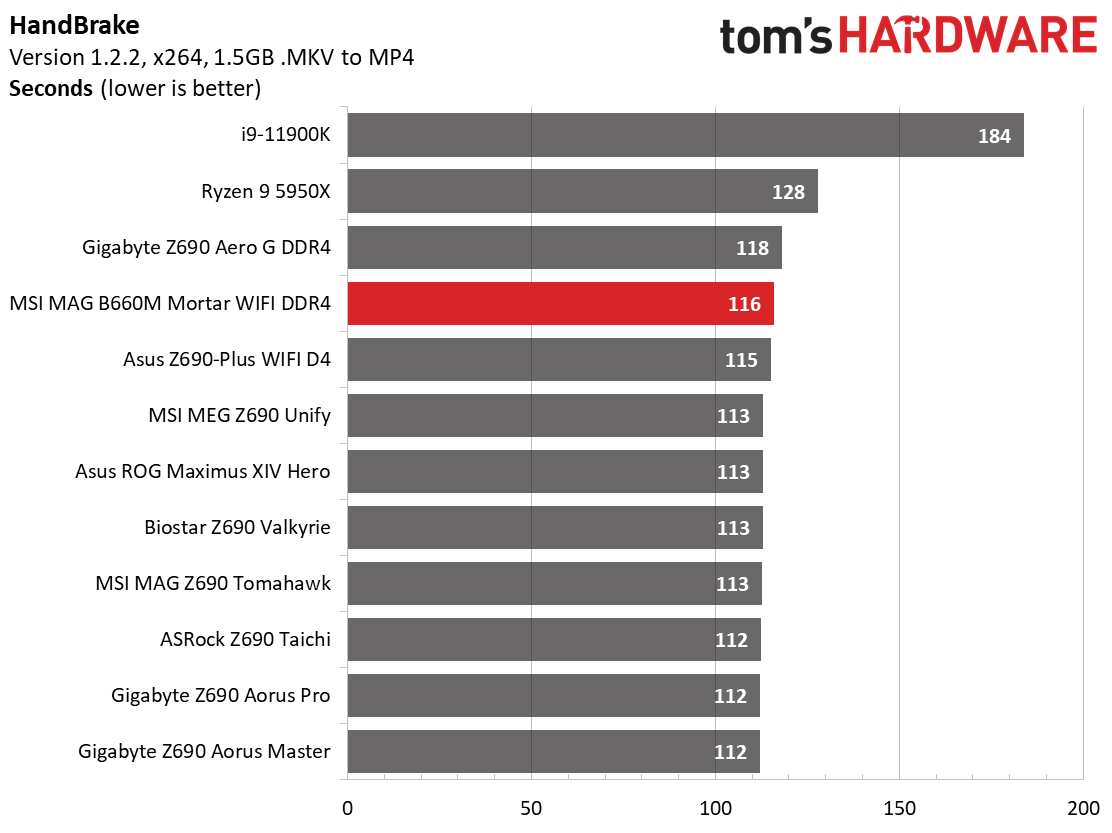

In the LAME test, the B660M Mortar was our fastest DDR4 result, completing the test in 9.82 seconds. The Asus was eight one-hundredths of a second slower, while the Aero G was notably slower at 10.7 seconds. All three DDR4 results are a couple percent slower than DDR5 results. That’s no not significant, but worth noting.
Corona testing was average, with the Mortar completing the test in 52 seconds and mixing with the DDR4 and DDR5 results. Both x264 and x265 Handbrake transcoding was slower than average, but in the middle of the DDR4 board results. There’s nothing extraordinary about the Corona or Handbrake results.
3D Games and 3DMark
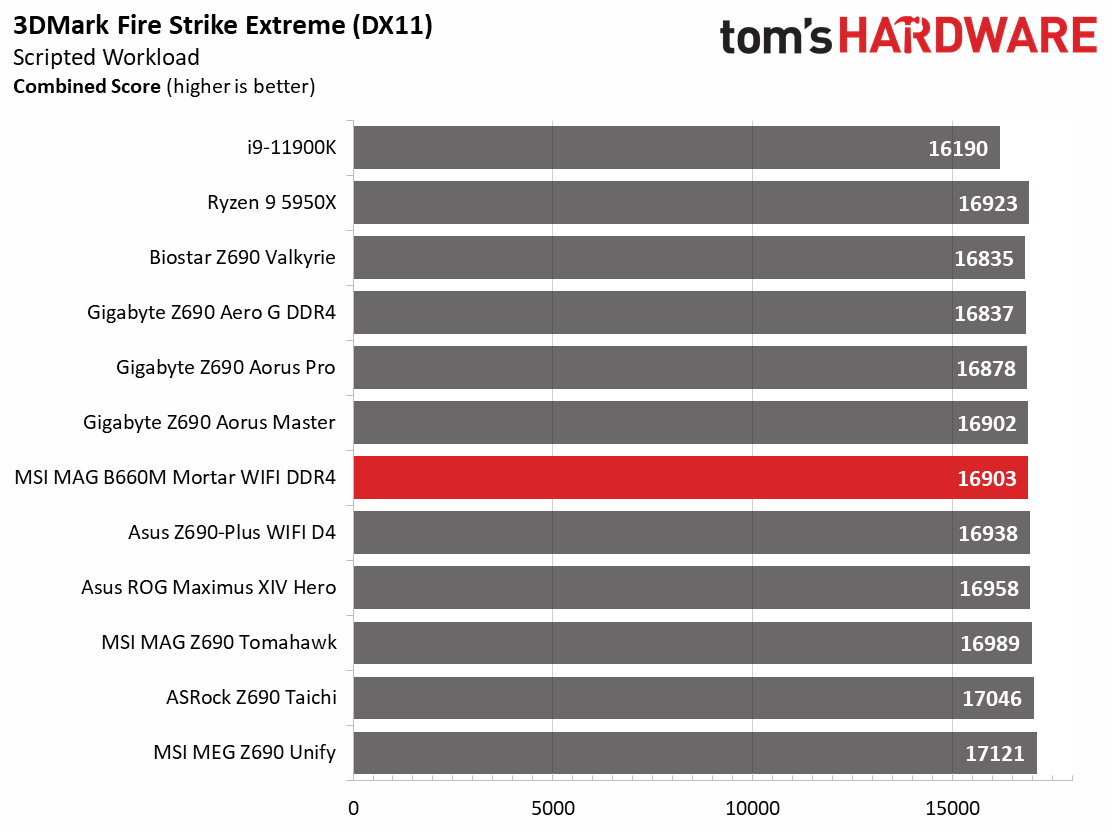
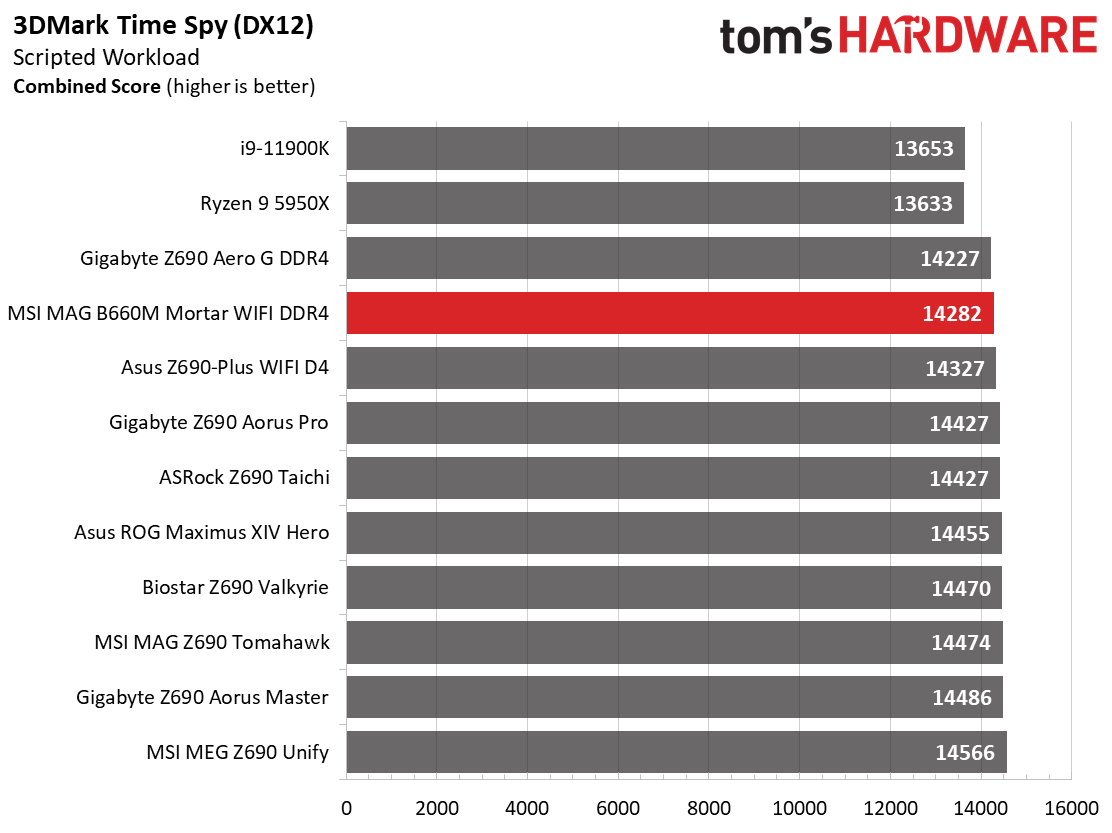
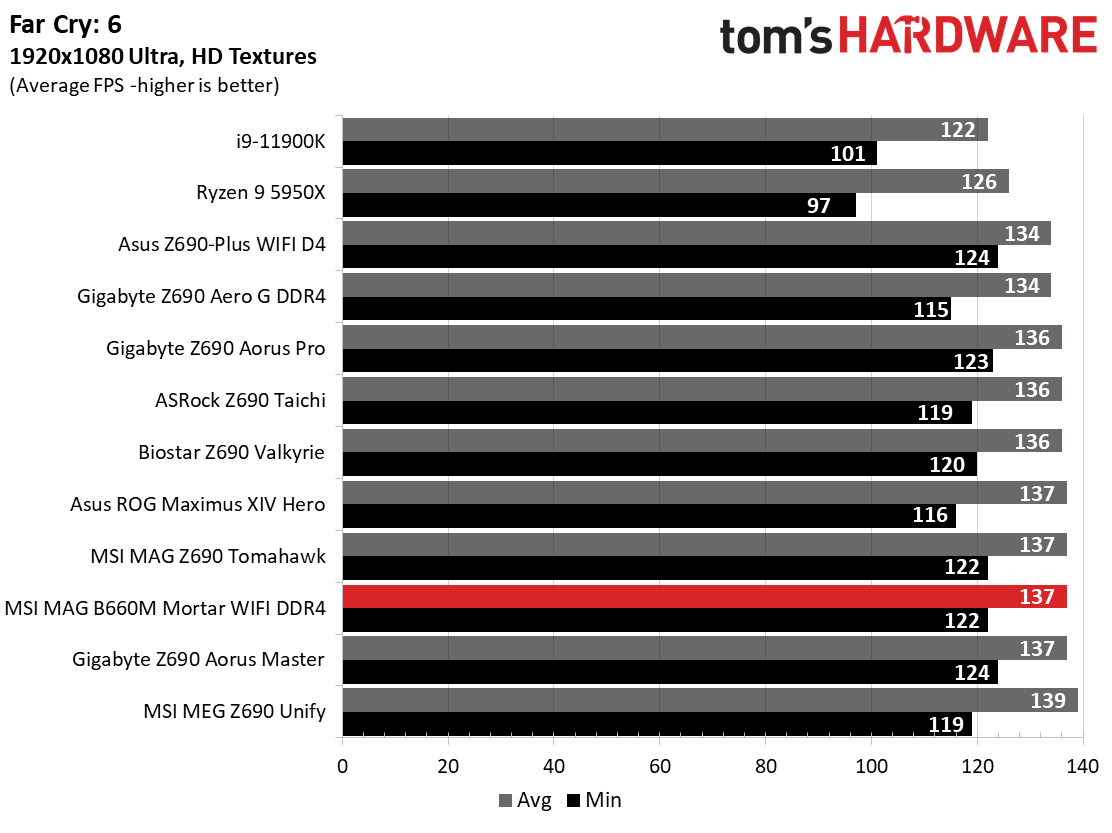
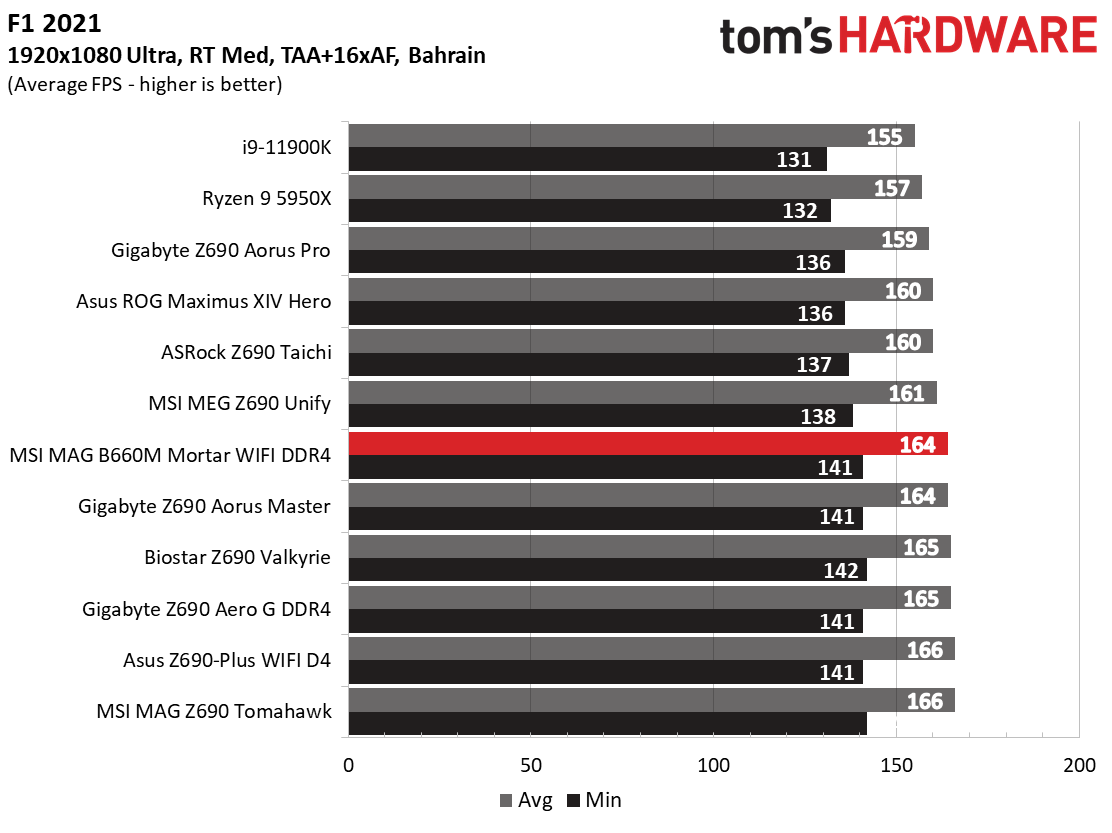
Starting with the launch of the Z690 chipset, we’ve updated our game tests. We’ve updated Far Cry: New Dawn to Far Cry 6 and shifted from F1 2020 to F1 2021. We run the games at 1920x1080 resolution using the Ultra preset (details listed above). As the resolution goes up, the CPU tends to have less impact. The goal with these settings is to determine if there are differences in performance at the most commonly used resolution with settings most people use or at least strive for. We expect the difference between boards in these tests to be minor, with most falling within the margin of error differences. We’ve also added a minimum fps value, as that can affect your gameplay and immersion experience.
Get Tom's Hardware's best news and in-depth reviews, straight to your inbox.
In F1 2021, the B660M Mortar averaged 164 frames per second (fps), with minimums of 141 fps. This result is higher than average, but still close to the other results. Far Cry 6 averaged 137 fps, with minimums of 122 fps. This result is one of the higher we’ve seen overall. Still, it would be difficult to tell the difference between boards when gaming unless you’re staring at the frame counter.
Our trend of not seeing a significant difference continues in our synthetic benchmarks. 3DMark Time Spy scored 14,282 (the second-lowest result so far), while in Fire Strike Extreme, 16,903 is average. Again, even with DDR4, the difference between the tested boards is negligible in this set of graphics and gaming tests.
Power Consumption / VRM Temperatures
We used AIDA64’s System Stability Test with Stress CPU, FPU and Cache enabled for power testing, using the peak power consumption value. The wattage reading is from the wall via a Kill-A-Watt meter to capture the entire PC minus the monitor. The only variable that changes is the motherboard; all other parts are the same.
At idle, the B660M Mortar used 51W, a tie for the most efficient result we’ve seen, matching the Gigabyte Z690 Aero G DDR4 we reviewed recently. Load wattage peaked at 297W, which falls around the average for Alder Lake-based motherboards we’ve tested. Overall, this board is among the most efficient motherboards tested using our i9-12900K processor, while still wielding the same 4.9/3.7 GHz all-core clocks at stock as most others.
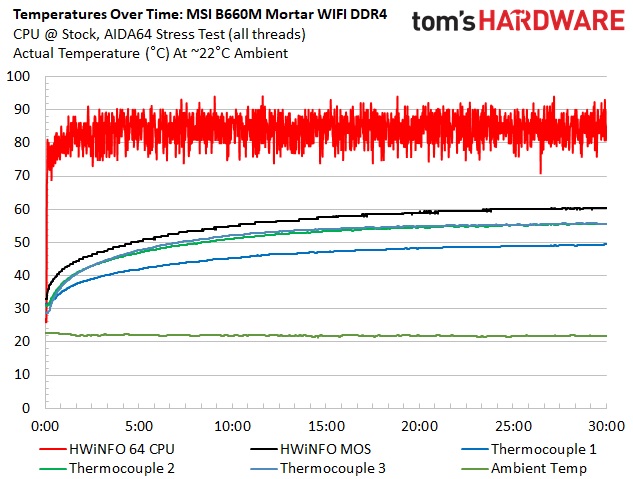
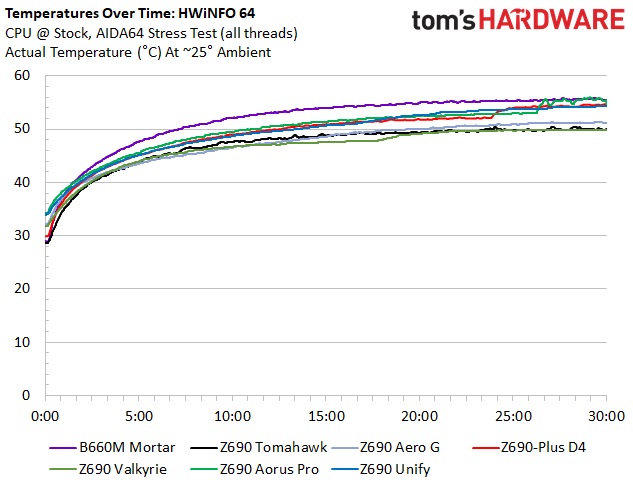
VRM temperatures on the Mortar peaked around 56 degrees Celsius during stock testing. This value was slightly higher than the others we’ve tested, but plenty cool and well within operating specifications. Even though this board runs warmer than the others we’ve tested so far, you can’t overclock the CPU anyway so this is as hot as it will get.
Overclocking
By this point, we should all know you can’t overclock the processor on this chipset, but overclocking the memory is possible. The B660M Mortar ran our DDR4 3600 kit using Gear 1 with good bandwidth and latency numbers, so we’re all set on that front. We swapped to our faster DDR4 4000 kit, enabled XMP, and off we went without a hiccup during stress testing. MSI lists support up to DDR4 4800+(OC), but your mileage may vary as achieving that result is highly dependant on the memory kit used and the quality of the IMC.
Now, about that whole not being able to overclock thing: On the B660M Mortar WIFI DDR4, and I suspect most others, you still have access to all of the turbo bins for the P-cores. In other words, for the i9-12900K, you’re able to set the multiplier up to 52x for all P-cores. The problem with doing this, or even 51x, is letting the V/F curve run wild. We’ve seen many boards use more voltage than needed when set to auto, which increases power use and temperatures. Even setting P-cores to 50x caused thermal throttling with the existing V/F curve. Since the Mortar doesn’t appear to have an option to control Vcore, we’re locked in at the default settings. However, if there’s a board that offers control over Vcore, you should be able to increase the all-core clocks.
Final Thoughts
Intel’s mainstream chipsets present users with an attractive platform to build a system on, especially when you consider the steep price increases we’ve endured over the past couple of generations of enthusiast-class platforms. For users who don’t plan on overclocking their processors, these no-frills boards offer a respite from spending extreme prices to get the full performance out of Intel Alder Lake-based processors.
MSI’s MAG B660M Mortar WIFI DDR4 showed us what an inexpensive board is capable of when paired with the i9-12900K and less expensive (and more readily available) DDR4. It may not have the fancy looks or RGB lighting of pricier boards but does come with everything you need to get the most out of the system stock-clocked. The Mortar includes two PCIe 4.0 x4 M.2 sockets, six SATA ports, a premium audio solution (albeit the last generation), and VRMs that easily manage the flagship processor.
Performance results on our B660M Mortar were similar to those of the Z690-based DDR4 boards we tested previously. In other words, this sub-$200 motherboard was able to utilize our i9-12900K processor to its fullest while costing a third less than most Z690 offerings. Now, sure, you don’t get four M.2 sockets and eight SATA ports, and more robust power delivery, but most just don’t need so much connectivity. There’s the argument for PCIe 5.0 as well (which most of these boards don’t have), but how long will it be until that becomes beneficial and, more importantly, affordable for most builders and gamers? So there’s a lot going for these boards–more so now than ever before, considering how little headroom there is when overclocking processors these days.
Speaking about the Mortar specifically, the only real shortcoming is the two M.2 sockets, but it is a Micro ATXboard. There’s certainly competition at this price point, but little information and pricing about other board partner SKUs was available when we wrote this, so it’s tough to compare head to head at this time. On its own though, the B660M Mortar WIFI DDR4 has everything most users will need to get the most out of any Alder Lake-based processor. Why pay more if you aren’t going to use the extra bandwidth?
So long as you don’t plan on overclocking your CPU or use PCIe 5.0 devices before your next upgrade, the MSI MAG B660M Mortar WIFI DDR4 and B660 makes for a great option for those looking to get into Alder Lake without breaking your build budget.
MORE: Best Motherboards
MORE: How To Choose A Motherboard
MORE: All Motherboard Content
| Synthetic Benchmarks and Settings | Row 0 - Cell 1 |
| Procyon | Version 2.0.249 64 |
| Row 2 - Cell 0 | Office Suite, Video Editing (Premiere Pro), Photo Editing (Photoshop, Lightroom Classic) |
| 3DMark | Version 2.20.7290 64 |
| Row 4 - Cell 0 | Firestrike Extreme and Time Spy Default Presets |
| Cinebench R23 | Version RBBENCHMARK330542 |
| Row 6 - Cell 0 | Open GL Benchmark - Single and Multi-threaded |
| Blender | Version 2.93.1 |
| Row 8 - Cell 0 | Full benchmark (all six sub-tests) |
| Application Tests and Settings | Row 9 - Cell 1 |
| LAME MP3 | Version SSE2_2019 |
| Row 11 - Cell 0 | Mixed 271MB WAV to mp3: Command: -b 160 --nores (160Kb/s) |
| HandBrake CLI | Version: 1.2.2 |
| Row 13 - Cell 0 | Sintel Open Movie Project: 4.19GB 4K mkv to x264 (light AVX) and x265 (heavy AVX) |
| Corona 1.4 | Version 1.4 |
| Row 15 - Cell 0 | Custom benchmark |
| 7-Zip | Version 21.03-beta |
| Row 17 - Cell 0 | Integrated benchmark (Command Line) |
| Game Tests and Settings | Row 18 - Cell 1 |
| Far Cry 6 | Ultra Preset - 1920 x 1080, HD Textures ON |
| F1 2021 | Ultra Preset - 1920 x 1080, HBAO+, RT Med, TAA + 16xAF, Bahrain, FPS Counter ON |
Current page: Benchmark Results and Final Analysis
Prev Page Firmware, Software and Test System
Joe Shields is a staff writer at Tom’s Hardware. He reviews motherboards and PC components.
-
shady28 So if I read this correctly, B660 does in fact allow overclocking? That's pretty big news actually.Reply -
render.man Reply
only memory oc, not cpushady28 said:So if I read this correctly, B660 does in fact allow overclocking? That's pretty big news actually.
b460 and b560 motherboards were released at a reasonable price ; B660 doesn't make sense at all at these prices -
shady28 Replyrender.man said:only memory oc, not cpu
b460 and b560 motherboards were released at a reasonable price ; B660 doesn't make sense at all at these prices
Article says they were able to do all core OC. They just couldn't control the V/F curve. -
render.man Replyshady28 said:Article says they were able to do all core OC. They just couldn't control the V/F curve.
you can run all cores at stock maxium speed
you can't change the multiplier with a B chipset -
shady28 Replyrender.man said:you can run all cores at stock maxium speed
you can't change the multiplier with a B chipset
Ok, I see the distinction. Technically correct, however most people are lucky to be able to set all core at max turbo. 10850K for example has a max single core turbo 5.2Ghz at stock, most people who 'overclock' on these shoot for 5.1Ghz all core. In my book this is actually a form of overclocking as the 10850K would never do all core 5.1Ghz by default.
It's just that you are limited to the max (5.2Ghz) single core speed, but can set all cores to that max. You probably won't be able to cool the thing without something like a $400+ custom open loop water setup beyond that anyway. -
render.man Another miss: this motherborad doesn't have PCIe 5.0 for GPUReply
There are also news about motherbords with b660 ( Asus, Asrock) with bclok overclock potential 8diXDeTDCboView: https://www.youtube.com/watch?v=8diXDeTDCbo
If this motherboard doesn't have this feature it's another miss. -
Ai90 Replyrender.man said:Another miss: this motherborad doesn't have PCIe 5.0 for GPU
Not big loss to be honest. There are no GPUs in Market, which require such bandwidth.
